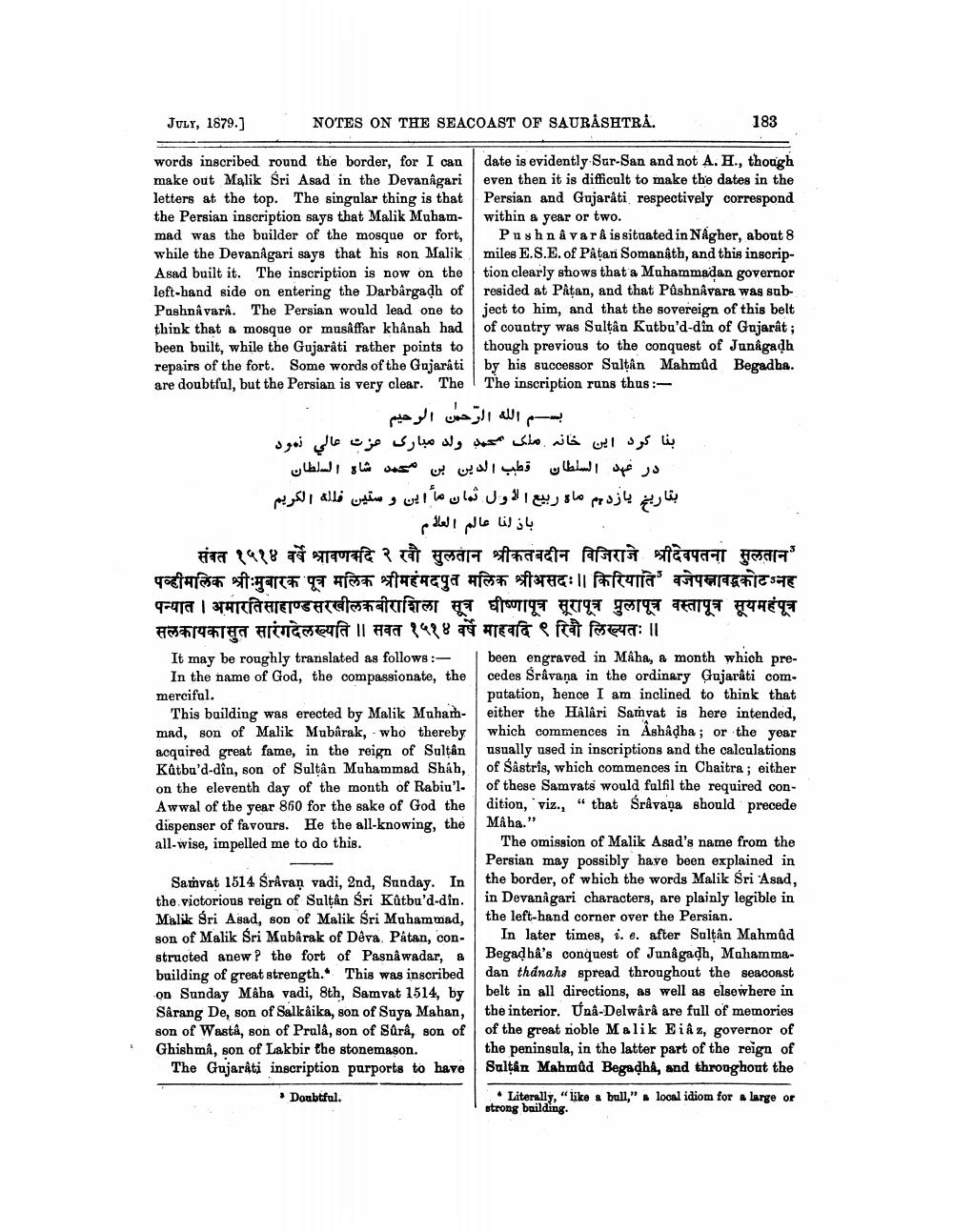________________
JULY, 1879.]
NOTES ON THE SEACOAST OF SAURÅSHTRÅ.
183
words inscribed round the border, for I can date is evidently Sur-San and not A. H., though make out Malik Sri Asad in the Devanagari even then it is difficult to make the dates in the letters at the top. The singular thing is that Persian and Gujarati respectively correspond the Persian inscription says that Malik Muham- within a year or two. mad was the builder of the mosque or fort, Push n â varâ is situated in NÁgher, about 8 while the Devanagari says that his son Malikmiles E.S.E. of Patan Somanath, and this inscripAsad built it. The inscription is now on the tion clearly shows that a Muhammadan governor left-hand side on entering the Darbârgadh of resided at Patan, and that Pashnavara was subPashnâ varả. The Persian would lead one to ject to him, and that the sovereign of this belt think that a mosque or musaffar khanah had of country was Sultan Kutbu'd-din of Gujarat; been built, while the Gujarati rather points to though previous to the conquest of Junagadh repairs of the fort. Some words of the Gujarati by his successor Sultan Mahmud Begadba. are doubtful, but the Persian is very clear. The The inscription runs thus:--
بسم الله الرحمن الرحيم :
عزت عالي نمود خانه ملک محمد ولد مبارک بنا کرد این
قطب الدین بن محمد شاه السلطان در عهد السلطان بتاریخ یازدهم ماه ربیع الاول ثمان مأین و ستين فلله الكريم
بان انا عالم العام
संवत १५१४ वर्षे श्रावणदि २ रवौ सुलतान श्रीकतबदीन विजिराजे श्रीदेवपतना सुलतान' पव्हीमलिक श्रीःमुबारक पूत्र मलिक श्रीमहंमदपुत मलिक श्रीअसदः॥ किरियाति' बजेपनावद्धकोटनह पन्यात । अमारतिसाहाण्डसरखीलकबीराशिला सूत्र घीष्णापूत्र सूरापूत्र फुलापूत्र वस्तापूत्र सूयमहंपूत्र सलकायकासुत सारंगदेलख्यति ।। सवत १५१४ वर्षे माहवदि ९ रिवी लिख्यतः ।।
It may be roughly translated as follows:- been engraved in Mâha, a month which pre
In the name of God, the compassionate, the cedes Sråvaņa in the ordinary Gujarati commerciful.
putation, hence I am inclined to think that This building was erected by Malik Muhamh- either the Hilari Samvat is here intended, mad, son of Malik Mubarak, - who thereby which commences in Ashadha; or the year acquired great fame, in the reign of Sultan usually used in inscriptions and the calculations Kûtba'd-dîn, son of Sultan Muhammad Shah, of Såstris, which commences in Chaitra ; either on the eleventh day of the month of Rabiu'l. of these Samvats would fulfil the required conAwwal of the year 860 for the sake of God the dition, viz., " that Sråvaņa should precede dispenser of favours. He the all-knowing, the Mâha." all-wise, impelled me to do this.
The omission of Malik Asad's name from the
Persian may possibly have been explained in Sarvat 1514 Śråvaņ vadi, 2nd, Sunday. In the border, of which the words Malik Sri Asad, the victorious reign of Sultan Sri Katbu'd-din. in Devanagari characters, are plainly legible in Malik Sri Asad, son of Malik Sri Muhammad, the left-hand corner over the Persian. son of Malik Sri Mubarak of Deva Patan, con- In later times, i.e. after Sultan Mahmad structed anew? the fort of Pasnâ wadar, a Begadha's conquest of Junagadh, Muhammabuilding of great strength. This was inscribed dan thdnahs spread throughout the seacoast on Sunday Maha vadi, 8th, Samvat 1514, by belt in all directions, as well as elsewhere in Sárang De, son of Salkäika, son of Suya Mahan, the interior. Una-Delwårå are full of memories son of Wasta, son of Prulå, son of Sura, son of of the great noble Malik Ei&z, governor of Ghishma, son of Lakbir the stonemason. the peninsula, in the latter part of the reign of The Gujarati inscription purports to have Sultan Mahmud Begadha, and throughout the Doubtful.
Literally," like a bull," local idiom for large or strong bailding.




